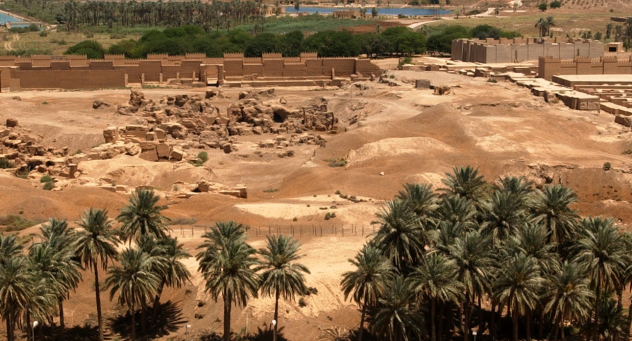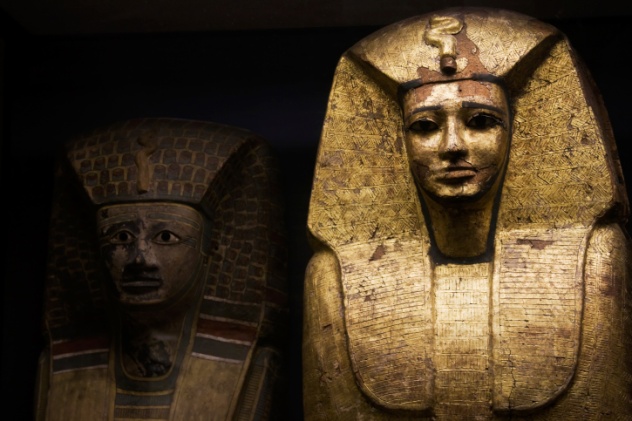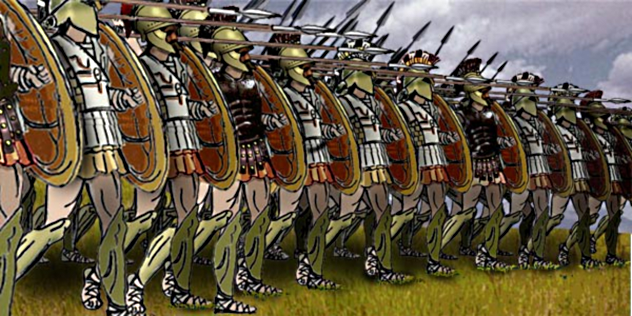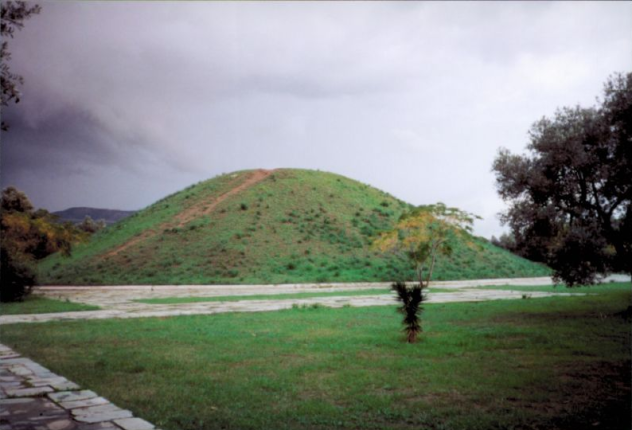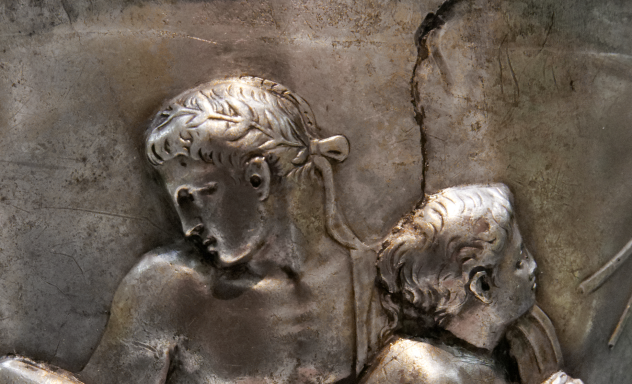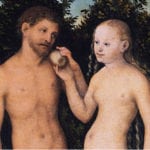10 Babylon The Behemoth
In Book One of The Histories, when Herodotus describes the physical and political atmosphere in Persia, he greatly exaggerates how massively fortified the city of Babylon is. According to Herodotus, the city of Babylon had “magnificence greater than all other cities of which we have knowledge.” He claims that 100 bronze gates were erected at the entrance of Babylon, and that Babylon’s walls were 100 meters (328 ft) high, 22 kilometers (14 mi) long, and 50 meters (164 ft) thick. He also says he saw a deep, water-filled trench that surrounded the entire perimeter of the city. Historians don’t agree on whether Herodotus ever actually visited Babylon; skeptics argue that he probably fabricated the details of his description of the city. Archaeological evidence tells us that Babylon had eight gates, not 100, and was not as grand as Herodotus boldly claimed. So, although he wrote about Babylon as if he himself had been there, he most likely never visited.
9 Giant Golden Ants
In Book Three, Herodotus claimed that huge furry ants, the size of foxes, lived in Persia and spread golden particles of dust as they dug in the sandy ground. Herodotus said that after these giant ants would dislodge the gold dust from the sand, the locals would collect the dust. For centuries, historians criticized this claim as outright fabricated until the 1990s, when a French explorer discovered that a marmot (a type of large squirrel) which lived in the Himalayas (India and Pakistan) spread gold dust when it dug the earth. The people who lived in this region, the Deosai Plateau, had a long oral tradition of describing how their ancestors collected gold dust from the ground. The Persian word for mountain ant was very similar to the Persian word for marmot, so Herodotus probably misunderstood the Persians he spoke to before he recounted the story. Although his description of the animals turned out to be a misunderstanding rather than an outright lie, Herodotus later asserted in Book Three that the “ants” were predators of adult camels, hunting and devouring them. Marmots probably haven’t done this.
8 Egyptian Embalming: Evisceration Enemas
In Book Two, Herodotus gives lengthy descriptions of Egypt, discussing the Nile River, mummification, Egyptian gender roles, animals, and holy festivals. However, most historians doubt whether Herodotus ever actually visited Egypt. For example, he gives detailed descriptions of the three great pyramids yet fails to mention the Sphinx, a highly suspect omission. (If he actually saw the pyramids, then he definitely would have seen the Sphinx.) Additionally, Herodotus writes about embalming, describing the three methods ranging from most expensive to least expensive. Herodotus claimed that elite, deceased Egyptians’ organs were removed from the left side of their abdomens, while commoners received cedar oil enemas to quickly remove the stomach and organs from the body. Our understanding of Egyptian embalming and mummification comes largely from Herodotus and other Greek historians like Diodorus of Sicily, but Herodotus got a lot wrong. Anthropologists in 2013 used CT scans of mummies and three-dimensional reconstructions to discredit Herodotus’s description of the Egyptian embalming process as inaccurate and not representative of what actually happened. We don’t know exactly what sources Herodotus used to get his information on Egyptian customs, but he most likely relied heavily on conversations with locals (who didn’t speak Greek), such as the people of Chemmis (the modern-day Egyptian city of Akhmim).
7 Gold-Hoarding Cyclopes And Griffins
Herodotus makes multiple references in Books Three and Four to one-eyed men (cyclopes, the plural of cyclops) called Arimaspoi. Claiming that these cyclopes steal gold from Grypes (griffins) in northern Europe, Herodotus is not merely relating a mythical story or poem about these creatures; he seems to seriously and sincerely believe that they exist. To prove his point that cyclopes and griffins live in Europe and that the griffins’ job is to guard stockpiles of gold, he refers to the Greek poet Aristeas and the Issedones (ancient residents of Central Asia), who mention the cyclopes and griffins in their stories. To further convince his readers that his writings about the cyclopes and griffins are accurate, Herodotus uses a little linguistic evidence: He says that the Scythians (Iranian nomads) call cyclopes “Arimaspoi” because in the Scythian language, arima means “one” and spou means “eye.” Unless and until archaeological evidence uncovers one-eyed humans and a half-lion, half-eagle creature, Herodotus is plain wrong.
6 Why The Nile River Floods
In Book Two, Herodotus talks about the Nile River, which regularly overflows and floods the Nile Delta and the areas of land on both sides of the river. He was fascinated by the behavior of the Nile, as he had never seen nor heard of any river that behaved like it. Herodotus really wanted to discover why the Nile rises for 100 days, starting on the summer solstice, before it retreats into low tide for winter. After correctly discounting Greek explanations for the cause of the Nile’s rising—the Etresian winds, the flow of the ocean, and melting snow—Herodotus explains his theory for why the Nile swells during summer. His theory is a little convoluted, involving winter storms that disrupt the usual course of the Sun, which dries out the streams in Libya that feed into the Nile. Unfortunately, Herodotus was mistaken about the Nile. We now know that the river actually floods in the summer months due to heavy tropical rainfall in Ethiopia.
5 Greeks vs. Persians: David And Goliath
Throughout The Histories, Herodotus discusses the Persian Wars (499–449 B.C.), a series of battles in which Greek city-states were defending their land and political power against the encroaching Persian empire. Because no Persian primary source accounts of the Persian Wars exist today, we have to rely on Greek sources. (Herodotus’s account is the most comprehensive and relatively contemporaneous.) However, since he was Greek, Herodotus was not completely impartial, and we have to closely examine his narrative for any pro-Greek, anti-Persian bias in order to get close to the truth. Describing the end of the Battle of Marathon, Herodotus claims that the corpses of 6,400 Persians were left on the battlefield, while only 192 Greeks (Athenians) were killed. Yes, it’s true that the Persian army was significantly larger than the Greek forces, and it’s accurate that the Greeks did conquer the Persians at Marathon. However, the numbers Herodotus uses are exaggerated on such a large scale that historians feel the need to investigate the accuracy of the rest of his accounts of military affairs. Since Herodotus was born six years after the Battle of Marathon, his sources for that information were Greeks who had been influenced and biased by the post-Marathon Athenian political climate. Athenians’ perspective was that their victory at Marathon made Athens the leader of Greece, which they used as the main justification for Athenian imperial policy.
4 Lion Cubs Clawing Their Way Out Of The Womb
When Herodotus wrote The Histories in the late 400s B.C., many philosophers were interested in discussing reproduction in the animal kingdom, specifically why some animals gave birth to multiple offspring at once. Herodotus claimed that timid creatures frequently give birth to multiple babies so that some will survive even though many are killed by predators. Conversely, harsh creatures (like lions) only conceive once a lifetime because they’re less likely to be killed and therefore not in danger of going extinct. Regarding lions, Herodotus says that lion cub fetuses use their sharp claws to scratch at their mother’s womb, scratching more and more until they’re born. The lioness can supposedly only give birth once because her womb is a mangled, scratched-up piece of useless flesh after giving birth. Aristotle called Herodotus ridiculous for this claim, and modern natural history has proved Herodotus completely wrong. He may have been guessing that the birth process was painful because the offspring was struggling to get out. He also may have based his claims on ancient medical writings, such as those by the Greek philosopher Democritus, but many accounts don’t survive today. To describe his belief that rabbits can conceive again while already pregnant, Herodotus used the word epikuisketai, an extremely unusual and scientifically technical term, which indicates that he probably did read medical writings about animal reproduction.
3 Marathon’s Mass Burial Battleground
The Battle of Marathon was hugely important to the Greeks because it symbolized their first victory over Persian tyranny. Herodotus claimed that the surviving Greeks buried the 192 slain Athenian soldiers in the middle of the battleground to pay tribute to them. For hundreds of years, archaeologists and researchers have excavated Marathon to try to find these Athenian remains. For years, a hill known as the soros (burial mound) has been considered to be the only serious candidate for Herodotus’s battlefield burial ground. A large number of burials certainly occurred at this location; many of them were men who died a violent death. Some of the burials include ceramics dating to around the time of Marathon. However, new research dates most of the ceramics that were buried with the dead as from the sixth century B.C.—long before the Battle of Marathon. Another problem is that the soros includes the bones of two women, who certainly were not fighting at Marathon.
2 Persian Pederasty
Pederasty, a relationship between adult men and adolescent boys, was a common cultural practice in ancient Greece. In Book One of The Histories, Herodotus states that the Greeks introduced pederasty to the Persians. In a passage describing the Persians’ clothing choices and polygamous lifestyle (they marry multiple wives and keep concubines), Herodotus remarks that Persians also copulate with boys—a practice they learned from the Hellenes (Greeks). Scholars have disagreed on the origin(s) of Persian pederasty since ancient times, and not many sources back up Herodotus’s claims. For example, Plutarch argued that Persian men had relations with eunuch boys long before they encountered Greek culture. However, we should keep in mind that Plutarch thought Herodotus was a total crackpot—he wrote On The Malice Of Herodotus, an essay criticizing The Histories for its inaccuracies and misrepresentations. Sextus Empiricus, a Greek philosopher, wrote that Persian law (which predated Persian exposure to Greeks) recommended pederasty. Whether Herodotus was wrong or not, we do know that the Greeks took pride in their culture. Plato listed pederasty, philosophy, and nude sports as three defining features that separated the Greeks from barbarians.
1 The Dolphin Who Saved A Famous Musician
In Book One of The Histories, Herodotus tells the story of Arion, a renowned harpist who performed for Periander, the ruler of Corinth. After winning money in a music competition in Sicily, Arion set sail back to Corinth. When the crew of his ship conspired to kill him for his money, Arion sang one last song before jumping overboard, and a dolphin carried him to safety to the Taenarum shore. Periander doubted Arion’s fantastical story until the scheming sailors showed up, were amazed to see Arion alive, and admitted their plot. We don’t know for sure if Herodotus believed that a dolphin saved Arion, but he acknowledged that it was a wonderful miracle. It’s easy to dismiss Arion’s story as fiction, myth, or metaphor or to argue that the dolphin was probably a piece of driftwood or another boat. However, there is some compelling evidence that the story could be true. First, Herodotus provides corroborating evidence—he says that the Corinthians and the Lesbians agree in their account of the story, dolphin included. Second, Herodotus describes a small bronze statue, dedicated to Arion, of a man on a dolphin’s back at Taenarum. Pausanias, a Greek traveler in the second century A.D., wrote that he saw this statue at Taenarum. Third, coins minted in Corinth and Tarentum depict nude men riding on dolphins. Finally, there are multiple modern reports of dolphins rescuing humans from maritime dangers like sharks. However, none of these dolphin-rescue reports are fully confirmed. Also, the image of a dolphin carrying a man to shore is very popular in Greek mythology. This fact, which may also explain the statue and coins, casts some level of doubt on Herodotus’s account of Arion’s rescue. Suzanne writes about indie music at After The Show.
